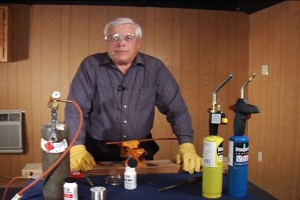I have read many articles and most say that copper lines must be soldered with silver-based compounds or low temperature brazed with copper-based compounds. Due to the high melting point of these soldering/brazing compounds, the lines must be purged with inert gases (such as nitrogen) to prevent oxides forming in the tubing. All of the above makes sense except: If jointing tubing can be accomplished at lower temperatures, the need for high heat and nitrogen purging can be eliminated. This seems like an important advantage (if the quality of the joint can be assured). What if low temperature soldering could do the job? What if for the mass-produced products, joining of plumbing could be accomplished in a low-temperature furnace (say 500 degrees F)? I've even read reports of refrigeration technicians admitting to soft soldering joints to save costs."
I would like to offer some thoughts. Soldering is a viable method of joining ACR tubing and components while servicing and installing refrigeration systems. However, not all types of solders can be used satisfactorily. Tin/lead and tin/antimony alloys are not normally recommended for our systems. They do not offer the required strength and ductility. However, a tin/silver alloy is a viable option and offers some distinct advantage over brazing.
Some advantages include the elimination of oxide scale formed by heating the joint. This means a nitrogen purge is not required during this process - which is a great saving for any technician. Not only will a technician save on the cost of the nitrogen; there is also a definite plus in not having to carry the nitrogen cylinder to the job. Another advantage of the use of a tin/silver alloy solder is the torch. A smaller torch with less heat can be used satisfactorily to solder the joint, meaning lighter or less equipment to bring on the jobsite. Less heat also means less chance of damaging components during the heating process, such as expansion valves and solenoids.
There is one exception to the use of a tin/silver alloy. Its applications are limited to service temperatures of less than approximately 200 degrees. When service temperatures exceed this, valve brazing may be a better option.
Another concern when choosing whether to braze or solder is the manufacturer of the equipment being serviced. It is generally best to follow a manufacturer's recommendation. Manufacturers generally tend to be very conservative in their recommendations and may recommend brazing over soldering for servicing their systems.
Here is a recommended procedure for soldering ACR tubing and components:
Measure, cut, deburr, clean, and apply the proper flux to the tubing. Make sure the flux used is specified for the type of filler metal being used. When applying the flux, apply it to the male fitting only, apply it sparingly, and do not apply flux to the end of the male fitting. If possible, rotate the male fitting 1/4 turn when inserting it into the female joint. Apply the flame to the joint. Heat the male tube near the joint first, and then move to the female fitting. Keep the torch moving in order to uniformly heat the parts and to prevent overheating any one area.
Move the flame away from the joint and then touch the solder to the joint. If the solder does not melt on contact with the joint, remove it and continue to heat the joint and then try again. Do not melt the solder with the flame.
When the joint temperature is hot enough to melt the solder, apply heat to the base of the fitting to help draw the solder into the joint. Continue to feed the solder until a ring of solder appears around the joint. After the joint is made, allow it to cool and then wipe away any residue flux. Do not allow any of the flux to remain on the joint as it is corrosive and may cause future problems. Remember, soldering is a viable option for refrigeration technicians while servicing and installing refrigeration systems. At times, it will make joining ACR tubing and components a much easier process.
Joe Marchese is owner of Coldtronics, Pittsburgh. He can be reached at 412-734-4433, www.coldtronics.com, or joe@rhvactools.com.
Publication date: 12/05/2005







